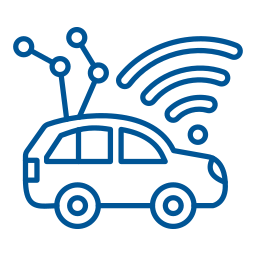-
Use Case: Cooperative sensing: exchange of sensor data (e.g., raw sensor data) and object information that increase vehicles environmental perception
Device(s)
To sense the environment, AVs use a combination of sensors: ・External sensors (GNSS, cameras, lidars etc.) ・Internal automotive sensors and actuators (brakes, steering wheel, accelerator, etc.) [1]- Joy, Joshua; Gerla, Marlo, IEEE, Internet of Vehicles and Autonomous Connected Car – Privacy and Security Issues
- Autonomous Vehicle Technology: A Guide for Policymaker
KPIs
E2E Latency: Low: <10ms Jitter: Sensitive Data Rate: Low: < 10 Mbps[2] Mate Boban, Apostolos Kousaridas, Konstantinos Manolakis, Joseph Eichinger, Wen Xu. “Use Cases, Requirements, and Design Considerations for 5G V2X”, arXiv:1712.01754v1 [cs.NI] 5 Dec 2017
Availability: Very high > 99.999%[3] 5G-PPP: Deliverable D2.1 5GCAR Scenarios, Use Cases, Requirements and KPIs. Version: v1.0, 2017-08-31, Available online: https://5gcar.eu/wp-content/uploads/2017/05/5GCAR_D2.1_v1.0.pdf
Criticality: Safety critical Communication Direction: Two-way Common Communication Mode: Unicast; Multicast; Broadcast Notes: Depends on the sensorData Reporting Mode: Hybrid Driven Notes: Event and continuousMobility (type/speed): High speed vehicular Service Continuity: Required Device Autonomy (Power Constrained): No Connectivity Type: LAN - WiFi; WAN - Cellular, LPWA, Satellite Priority Services (NS/EP): No (it would not) Guaranteed Service: Delayed-Critical GBR Security: High Lifespan: Long: More than 8 years Device Density: High (≥10000) Location Based Services: Very High Accuracy (less than 1M) Slice Type Slice Type: V2X -
Use Case: Cooperative maneuvers: include a wide range of use cases (e.g., cooperative collision avoidance, cooperative lane change)
Device(s)
To sense the environment, AVs use a combination of sensors: ・External sensors (GNSS, cameras, lidars etc.) ・Internal automotive sensors and actuators (brakes, steering wheel, accelerator, etc.)[4]Autonomous Vehicle Technology: A Guide for Policymakers
Joy, Joshua;Gerla, Marlo, IEEE, Internet of Vehicles and Autonomous Connected Car – Privacy and Security Issues
KPIs
E2E Latency: Low: <10ms Jitter: Sensitive Data Rate: Low: < 10 Mbps Notes: For cooperative collision avoidance maximum expected data rate for each vehicle (1.3 Mbps) For lane change, data rate 0.350 to 6.4 Mbp[5]Mate Boban, Apostolos Kousaridas, Konstantinos Manolakis, Joseph Eichinger, Wen Xu. “Use Cases, Requirements, and Design Considerations for 5G V2X”, arXiv:1712.01754v1 [cs.NI] 5 Dec 2017
5G-PPP: Deliverable D2.1 5GCAR Scenarios, Use Cases, Requirements and KPIs. Version: v1.0, 2017-08-31, Available online: https://5gcar.eu/wp-content/uploads/2017/05/5GCAR_D2.1_v1.0.pdfAvailability: Very high > 99.999% Notes: V2I/V2N 99%; V2V 99.9%[6]5G-PPP: Deliverable D2.1 5GCAR Scenarios, Use Cases, Requirements and KPIs. Version: v1.0, 2017-08-31, Available online: https://5gcar.eu/wp-content/uploads/2017/05/5GCAR_D2.1_v1.0.pdf
Criticality: Safety critical Communication Direction: Two-way Common Communication Mode: Unicast; Multicast; Broadcast Notes: Depends on the sensorData Reporting Mode: Hybrid Driven Notes: Event and continuousMobility (type/speed): High speed vehicular Service Continuity: Required Device Autonomy (Power Constrained): No Connectivity Type: WAN - Cellular, LPWA, Satellite Priority Services (NS/EP): No (it would not) Guaranteed Service: Delayed-Critical GBR Security: High Lifespan: Long: More than 8 years Device Density: High (≥10000) Location Based Services: Very High Accuracy (less than 1M) Slice Type Slice Type: V2X -
Use Case: High density platooning
High density platooning refers to a group of vehicles driving closely together in a convoy, with the lead vehicle controlling the speed and direction of the others. The vehicles in the platoon are equipped with advanced communication and sensor technology, which allows them to maintain a consistent distance from one another, even in heavy traffic or adverse weather conditions. High-density platooning can help to reduce traffic congestion and improve safety on the road by allowing vehicles to drive more closely together in a coordinated manner.Device(s)
To sense the environment, AVs use a combination of sensors: ・External sensors (GNSS, cameras, lidars etc.) ・Internal automotive sensors and actuators (brakes, steering wheel, accelerator, etc.) [7]Autonomous Vehicle Technology: A Guide for Policymakers
Joy, Joshua;Gerla, Marlo, IEEE, Internet of Vehicles and Autonomous Connected Car – Privacy and Security IssuesKPIs
E2E Latency: Low: <10ms Notes: Latency 50ms[8]5G-PPP: Deliverable D2.1 5GCAR Scenarios, Use Cases, Requirements and KPIs. Version: v1.0, 2017-08-31, Available online: https://5gcar.eu/wp-content/uploads/2017/05/5GCAR_D2.1_v1.0.pdf
Jitter: Sensitive Data Rate: Low: < 10 Mbps Notes: Data rate >25M[9]Mate Boban, Apostolos Kousaridas, Konstantinos Manolakis, Joseph Eichinger, Wen Xu. “Use Cases, Requirements, and Design Considerations for 5G V2X”, arXiv:1712.01754v1 [cs.NI] 5 Dec 2017
5G-PPP: Deliverable D2.1 5GCAR Scenarios, Use Cases, Requirements and KPIs. Version: v1.0, 2017-08-31, Available online: https://5gcar.eu/wp-content/uploads/2017/05/5GCAR_D2.1_v1.0.pdf
Availability: Very high > 99.999% Criticality: Safety critical Communication Direction: Two-way Common Communication Mode: Unicast; Multicast; Broadcast Notes: Depends on the sensorData Reporting Mode: Hybrid Driven Notes: Event and continuousMobility (type/speed): High speed vehicular Service Continuity: Required Device Autonomy (Power Constrained): No Connectivity Type: WAN - Cellular, LPWA, Satellite Priority Services (NS/EP): No (it would not) Guaranteed Service: Delayed-Critical GBR Security: High Lifespan: Long: More than 8 years Device Density: High (≥10000) Location Based Services: Very High Accuracy (less than 1M) Slice Type Slice Type: V2X -
Use Case: See-through - real-time exchange of live video images and high throughput sensor data from surround cameras. In a typical “see-through” use case scenario, a vehicle following a large truck with limited forward visibility can receive high-quality, real-time video feeds from cameras installed on the trunk or other nearby vehicles to gain visibility.
Device(s)
Vision-based sensor (e.g., stereo camera)KPIs
E2E Latency: Moderate: 10ms-100ms Jitter: Sensitive Data Rate: Medium: 10 – 50 Mbps[10] Mate Boban, Apostolos Kousaridas, Konstantinos Manolakis, Joseph Eichinger, Wen Xu. “Use Cases, Requirements, and Design Considerations for 5G V2X”, arXiv:1712.01754v1 [cs.NI] 5 Dec 2017
Availability: Medium: 90 - 95% Notes: 99%[11]5G-PPP: Deliverable D2.1 5GCAR Scenarios, Use Cases, Requirements and KPIs. Version: v1.0, 2017-08-31, Available online: https://5gcar.eu/wp-content/uploads/2017/05/5GCAR_D2.1_v1.0.pdf
Criticality: Safety critical Communication Direction: One-way Common Communication Mode: Multicast Data Reporting Mode: Hybrid Driven Notes: Event and continuousMobility (type/speed): High speed vehicular Service Continuity: Required Device Autonomy (Power Constrained): No Connectivity Type: WAN - Cellular, LPWA, Satellite Priority Services (NS/EP): No (it would not) Guaranteed Service: Delayed-Critical GBR Security: High Lifespan: Long: More than 8 years Device Density: High (≥10000) Location Based Services: Very High Accuracy (less than 1M) Slice Type Slice Type: V2X -
Use Case: Vulnerable road user - warnings are provided for vulnerable road users (e.g., pedestrians, bicyclists, wheelchair users, etc.) to avoid collision with moving vehicle, use of local communication systems can assist in the detection of a crossing vulnerable road user (VRU) by the use of an intelligent roadside unit which captures the VRU’s messages and transit them to the approaching vehicles.
Device(s)
Sensors based on radar, visual or infrared technology integrated into the road infrastructure. The sensors detect approaching road users and signal this to the road users by visual and audio warnings.[12]Carels David, Vandenberghe Wim,Moerman Ingrid,Demeester Piet, “ARCHITECTURE FOR VULNERABLE ROAD USER COLLISION PREVENTION SYSTEM (VRU-CPS), BASED ON LOCAL COMMUNICATION”.
KPIs
E2E Latency: Moderate: 10ms-100ms Notes: Latency <60ms[13]5G-PPP: Deliverable D2.1 5GCAR Scenarios, Use Cases, Requirements and KPIs. Version: v1.0, 2017-08-31, Available online: https://5gcar.eu/wp-content/uploads/2017/05/5GCAR_D2.1_v1.0.pdf
Jitter: Sensitive Data Rate: Low: < 10 Mbps Availability: High: 95 - 99.999% Notes: 99% to 99.99%[14]5G-PPP: Deliverable D2.1 5GCAR Scenarios, Use Cases, Requirements and KPIs. Version: v1.0, 2017-08-31, Available online: https://5gcar.eu/wp-content/uploads/2017/05/5GCAR_D2.1_v1.0.pdf
Criticality: Safety critical Communication Direction: One-way Common Communication Mode: Multicast Data Reporting Mode: Hybrid Driven Notes: Event and continuousMobility (type/speed): Fixed Service Continuity: Required Device Autonomy (Power Constrained): No Connectivity Type: WAN - Cellular, LPWA, Satellite Priority Services (NS/EP): No (it would not) Guaranteed Service: Delayed-Critical GBR Security: High Lifespan: Long: More than 8 years Device Density: High (≥10000) Location Based Services: Very High Accuracy (less than 1M) Slice Type Slice Type: V2X -
Use Case: Teleoperated driving enables operation of a vehicle by a remote driver.
Device(s)
Sensor information (e.g., LIDAR, RADARs), vehicle Status (e.g., speed) and video streaming images (e.g., two cameras (front, end))KPIs
E2E Latency: Low: <10ms Jitter: Sensitive Data Rate: Medium: 10 – 50 Mbps Notes: 25 Mbps uplink data rate is derived from two or more cameras (e.g., front, side, back) and other sensor information that is required to provide to the human operator experience similar to that of a regular driver of the car. Resulting traffic demand is approximately 10 Mb/s for each H.265/HEVC High Definition (HD) video stream[15]Mate Boban, Apostolos Kousaridas, Konstantinos Manolakis, Joseph Eichinger, Wen Xu. “Use Cases, Requirements, and Design Considerations for 5G V2X”, arXiv:1712.01754v1 [cs.NI] 5 Dec 2017
Availability: Very high > 99.999% Notes: 99.999%[16]5G-PPP: Deliverable D2.1 5GCAR Scenarios, Use Cases, Requirements and KPIs. Version: v1.0, 2017-08-31, Available online: https://5gcar.eu/wp-content/uploads/2017/05/5GCAR_D2.1_v1.0.pdf
Criticality: Safety critical Communication Direction: Two-way Common Communication Mode: Unicast Data Reporting Mode: Continuous-based Mobility (type/speed): High speed vehicular Service Continuity: Required Device Autonomy (Power Constrained): No Connectivity Type: WAN - Cellular, LPWA, Satellite Priority Services (NS/EP): No (it would not) Guaranteed Service: Delayed-Critical GBR Security: High Lifespan: Long: More than 8 years Device Density: High (≥10000) Location Based Services: Very High Accuracy (less than 1M) Slice Type Slice Type: V2X

